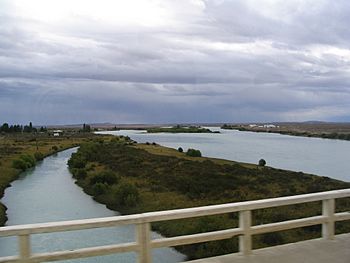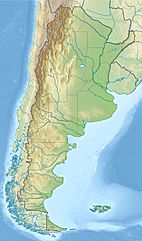Santa Cruz River (Argentina) facts for kids
Quick facts for kids Santa Cruz River |
|
|---|---|

Crossing the Santa Cruz River at Comandante Luis Piedra Buena, Argentina
|
|
|
Location of mouth
|
|
| Country | Argentina |
| Physical characteristics | |
| River mouth | 50°08′S 68°21′W / 50.133°S 68.350°W |
The Santa Cruz River (Spanish: Río Santa Cruz) is an important river in the Argentine province of Santa Cruz. It starts from two large lakes, Viedma and Argentino Lake, which are fed by glaciers. These lakes are found in the beautiful Los Glaciares National Park.
The river flows about 385 kilometers (239 miles) east. It eventually reaches the Atlantic Coast, forming a delta. This spot is about 350 kilometers (217 miles) north of the very southern tip of South America. The Santa Cruz River is special because it is one of the last big rivers in Patagonia that still flows freely, without many changes from humans.
Contents
Building Dams on the River
The Santa Cruz River has a strong flow of water. On average, about 790 cubic meters (1,033 cubic yards) of water pass by each second. This water is used for watering farms.
There are plans to build two big dams on the river. These dams are called the Jorge Cepernic and Nestor Kirchner Dams. Together, they will be able to produce a lot of electricity, up to 1,740 megawatts. Companies from China and Argentina were chosen to build these dams in 2013. However, some people are worried that building these dams could harm more than half of the Santa Cruz River's natural environment.
River History and Explorers
The Santa Cruz River has a rich history, especially with European explorers.
Magellan's Discovery
Europeans first discovered the Santa Cruz River in 1520. This happened during Ferdinand Magellan's famous trip around the world. One of his captains, Juan Serrano, found the river on August 5, 1520.
Magellan learned that the river was a good place to stop. He decided to move his fleet there from another place called St. Julian. They arrived around August 24 and stayed at Santa Cruz for about six weeks. After resting, they continued their search for a passage that would connect the Atlantic Ocean to the Pacific Ocean. This passage is now known as the Magellan Strait.
Darwin's Expedition on HMS Beagle
In April 1834, the famous ship Beagle needed repairs. Its captain, Robert FitzRoy, chose the Santa Cruz River as a good place to fix the ship. While the repairs were happening, FitzRoy led an expedition up the river. He wanted to find its source, which was about 300 kilometers (186 miles) away in the Andes mountains.
On April 18, three boats set out with 25 men. This group included Captain FitzRoy and the famous naturalist Charles Darwin. For 16 days, everyone took turns pulling the boats up the river. Darwin carefully observed everything around him. He wrote down details about the land, the plants and animals, and the rocks the river cut through.
Darwin noticed that the land was very similar everywhere in Patagonia. He wrote that the dry, stony plains had the same small plants. The valleys also had the same thorny bushes. Even the birds and insects were the same. He felt the land was "sterile" or barren, meaning it didn't have much life. He also noted that the river's clear water, flowing over pebbles, seemed to lack much life too, which meant few waterfowl.
Darwin was very interested in the stepped plains of pebbles along the river. These steps showed how the land had changed over a very long time. He thought that at one point, the Santa Cruz River might have been a sea-strait, cutting through the continent. He believed that the southern part of South America might have been a group of islands back then.
The expedition had to turn back because they were running out of supplies. If they had gone a little further, they would have found that the river's source was Lago Argentino, a glacial lake at the foot of the mountains.
On May 4, Captain FitzRoy decided they couldn't go any higher up the river. The river was winding and very fast. The land still looked the same and wasn't very interesting. They were about 140 miles from the Atlantic Ocean and 60 miles from the Pacific. The valley opened up into a wide basin, with mountains in the distance. They wished they could have reached the mountain tops. They had been on half rations of bread for several days, which made the hard journey even tougher.
On May 5, they started their journey back down the river. They went very fast, sometimes at 10 knots (about 11.5 miles per hour). What took them five and a half hard days to go up, they did in just one day going down! They reached the Beagle on May 8, after a 21-day trip. Darwin found the journey very interesting because it showed him a lot about the geology of Patagonia.
See also
 In Spanish: Río Santa Cruz para niños
In Spanish: Río Santa Cruz para niños


